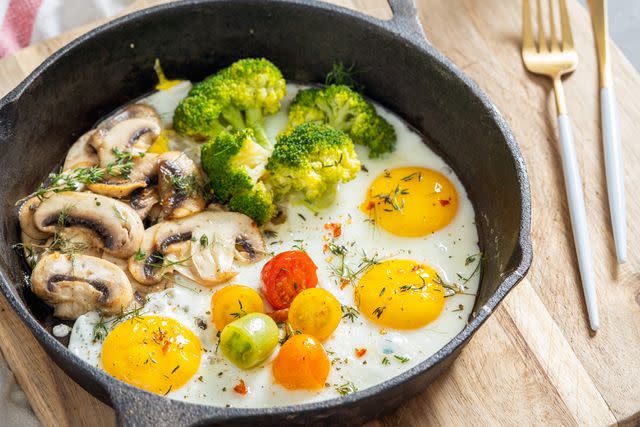5 Things You Shouldn't Cook in a Cast-Iron Skillet
This might just be your most finnicky kitchen tool
A cast-iron skillet can last a lifetime; that is, if you treat it right. The seasoning process is the key to caring for and maintaining cast-iron. And while it can be a tedious chore, it’s truly the only way to properly clean and keep your skillet or pan in the best condition for an extended period of time. Continuously seasoning your cast-iron will also help you better cook certain foods that have a stickier consistency.
But don’t be discouraged if you’ve burned an omelet or tried to prepare a tomato-based sauce in a newer cast-iron, only to be left with a total #dinnerfail. The making of a smooth, non-stick pan takes time, and until you’ve reached that level, here are some foods you should certainly avoid making in your cast-iron skillet.
Related: 10 Best Cast-Iron Skillet Recipes to Make All Year Round

Carlo A/Getty Images
Eggs
Since a new cast-iron skillet is incredibly porous, eggs are perhaps the worst thing you could cook. Not only will your eggs cook unevenly, but you’ll spend your morning scraping egg scraps off the bottom of the pan. However, once your cast-iron pan is seasoned over time, you’ll be able to make the most delectable fried eggs and fluffy frittatas, like this Zucchini Frittata With Parmesan.
Fish (some varieties)
A good rule of thumb is to only cook thicker cuts of fish in a cast-iron skillet. Tuna, mahi-mahi, and swordfish steaks are perfect for searing, and can withstand the heat. Delicate types of fish like sole, cod, flounder, and even salmon will likely stick to the pan and leave a bit of a mess. You’ll want to deep clean and season your pan after cooking any type of fish, otherwise, your next dish might take on that polarizing fishy flavor.
Desserts (if previously used for dinner)
As we mentioned above, skillets and pans made from cast-iron are incredibly porous, which means that they hold onto flavors unless properly seasoned and cleaned. So, while an oversized cookie skillet or brownie sounds heavenly, you should always make sure your pan was thoroughly cleaned from the previous meal before using your cast-iron skillet to make dessert.
Acidic Foods
Cast-iron skillets and acidic foods just don’t mix unless it’s super snappy. If you’re making a rich tomato sauce, wine-braised meat, or a lemon-based marinade, you might want to consider using a stainless steel or ceramic pot or pan. Acidic foods will strip away metals in even the most seasoned cast-iron cookware, and those metals will get into whatever you’re cooking.
Related: 6 Things You Shouldn't Cook in an Instant Pot
Potent Ingredients
When it comes to cooking with your cast-iron, it’s always a good idea to consider the ingredients you’re using. Just because something might not stick to the pan, that doesn't mean it can't leave your cookware smelling of food remnants, even after an extensive seasoning process. Dishes with potent ingredients, like curry, chipotle, and cumin, may be best prepared in alternative cookware to avoid a cleaning hassle.
For more Real Simple news, make sure to sign up for our newsletter!
Read the original article on Real Simple.

